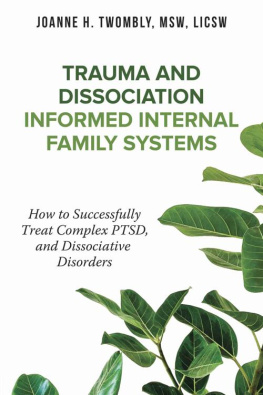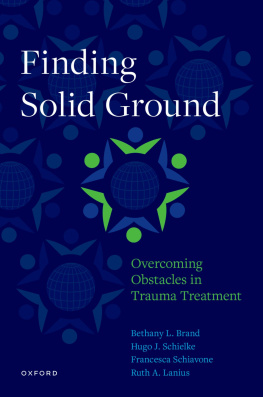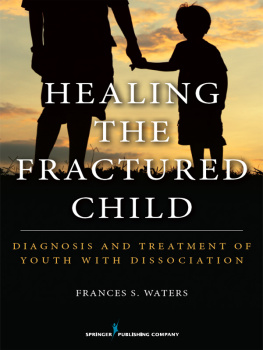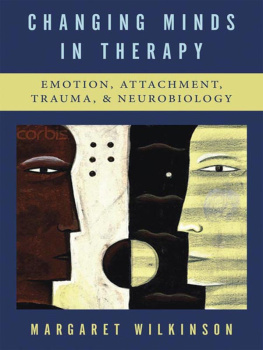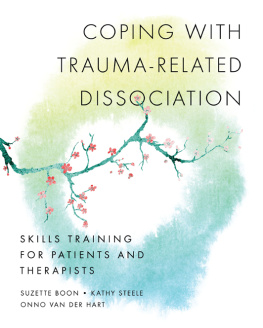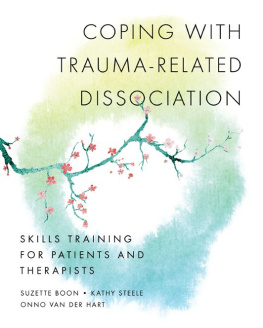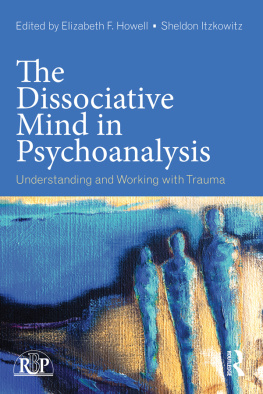Bromberg - Standing in the spaces - essays on clinical process trauma and dissociation
Here you can read online Bromberg - Standing in the spaces - essays on clinical process trauma and dissociation full text of the book (entire story) in english for free. Download pdf and epub, get meaning, cover and reviews about this ebook. year: 2001, publisher: Taylor & Francis (CAM), genre: Religion. Description of the work, (preface) as well as reviews are available. Best literature library LitArk.com created for fans of good reading and offers a wide selection of genres:
Romance novel
Science fiction
Adventure
Detective
Science
History
Home and family
Prose
Art
Politics
Computer
Non-fiction
Religion
Business
Children
Humor
Choose a favorite category and find really read worthwhile books. Enjoy immersion in the world of imagination, feel the emotions of the characters or learn something new for yourself, make an fascinating discovery.
Standing in the spaces - essays on clinical process trauma and dissociation: summary, description and annotation
We offer to read an annotation, description, summary or preface (depends on what the author of the book "Standing in the spaces - essays on clinical process trauma and dissociation" wrote himself). If you haven't found the necessary information about the book — write in the comments, we will try to find it.
Bromberg: author's other books
Who wrote Standing in the spaces - essays on clinical process trauma and dissociation? Find out the surname, the name of the author of the book and a list of all author's works by series.
Standing in the spaces - essays on clinical process trauma and dissociation — read online for free the complete book (whole text) full work
Below is the text of the book, divided by pages. System saving the place of the last page read, allows you to conveniently read the book "Standing in the spaces - essays on clinical process trauma and dissociation" online for free, without having to search again every time where you left off. Put a bookmark, and you can go to the page where you finished reading at any time.
Font size:
Interval:
Bookmark:

Standing in the Spaces
STANDING IN THE SPACES
Essays on Clinical Process, Trauma, and Dissociation
PHILIP M. BROMBERG

1998 by Psychology Press
First paperback printing 2001
All rights reserved. No part of this book may be reproduced, stored, or transmitted in any way whatsoever without the prior written permission of the publisher.
Index by Leonard S. Rosenbaum
Journal, Book, and Publisher Acknowledgments
The author gratefully acknowledges the following publications in whose pages versions of most chapters first appeared: Journal of the American Academy of Psychoanalysis [chapter 6]; Psychoanalytic Psychology [chapter 2]; Contemporary Psychoanalysis [chapters 2, 3, 4, 5, 7, 8, 9, 14 and 17]; Psychoanalytic Dialogues [chapters 10, 15 & 16, and chapters 13 and 18, which are derived from the earlier forms of these essays but have been materially rewritten and expanded for this volume]; Self Psychology: Comparisons and Contrasts (ed. D. W. Detrick and S. P. Detrick, The Analytic Press 1989) [chapter 11].
The author thanks also the Journal of the American Psychoanalytic Association, the Journal of Clinical Psychoanalysis, Contemporary Psychotherapy Review, Dynamic Psychotherapy, and The Analytic Press, publisher of Pioneers of Interpersonal Psychoanalysis (ed. D. B. Stern, C. H. Mann, S. Kantor & G. Schlesinger, 1955) for permission to use in chapters 1 and 19 some selected content adapted from referenced articles not included as chapters.
Library of Congress Cataloging-in-Publication Data
Bromberg, Philip M.
Standing in the Spaces: Essays on Clinical Process, Trauma, and Dissociation / Philip M. Bromberg
p. cm.
Includes bibliographical references and index.
ISBN: 0-88163-356-9
1. Psychoanalysis. 2. Psychic trauma. 3. Dissociation (Psychology).
Psychotherapist and patient. I. Title
[DNLM: 1. Psychoanalytic Therapy collected works. 2. Mental Disorderstherapy collected works. 3. Psychoanalytic Theory collected works. WM
460.6B868s 1998]
RC509.B76 1998
616.8917-dc21
DNLM/DLC
| for Library of Congress | 98-29429 CIP |
For Margo
CONTENTS
4 Empathy, Anxiety, and Reality:
A View from the Bridge (1980)
5 Getting Into Oneself and Out of Ones Self:
On Schizoid Processes (1984)
6 The Use of Detachment in Narcissistic
and Borderline Conditions (1979)
7 The Mirror and the Mask:
On Narcissism and Psychoanalytic Growth (1983)
8 On the Occurrence of the Isakower
Phenomenon in a Schizoid Patient (1984)
10 On Knowing Ones Patient Inside Out:
The Aesthetics of Unconscious Communication (1991)
11 Interpersonal Psychoanalysis and Self Psychology:
A Clinical Comparison (1989)
12 Shadow and Substance:
A Relational Perspective on Clinical Process (1993)
13 Psychoanalysis, Dissociation, and
Personality Organization (1995)
14 Resistance, Object Usage, and
Human Relatedness (1995)
15 Hysteria, Dissociation, and Cure:
Emmy von N Revisited (1996)
16 Speak! That I May See You:
Some Reflections on Dissociation, Reality, and Psychoanalytic Listening (1994)
17 Standing in the Spaces:
The Multiplicity of Self and the Psychoanalytic Relationship (1996)
18 Staying the Same While Changing:
Reflections on Clinical Judgment (1998)
T he primary fountainhead of nourishment for the writing of these essays has been my patients, necessarily anonymous, and it is through the give-and-take of these relationships that my contemplation of clinical process continues to draw its vitality. In each treatment I discover in some new way that my ability to facilitate a patients growth exists to the degree that I allow his or her impact to change me in ways I had not anticipated.
My ideas have germinated in different psychoanalytic communities at different points in time. The William Alanson White Institute, home of my analytic training, remains the most significant influence that has shaped my sensibility as a therapist. There are several people from my years as a candidate and thereafter to whom my gratitude is particularly alive, foremost among them being Edgar Levenson, whose impact on my thinking is evident from the first to the final chapter. I also want to express my appreciation to Earl Witenberg, Director of the White Institute during most of my career, and to Arthur Feiner, Editor Emeritus of Contemporary Psychoanalysis. At a time when support of my writing efforts was most needed, each in his own way provided me with opportunities to express my ideas regardless of whether I crossed the traditional boundary of interpersonal orthodoxy.
The evolution of my writing has further been shaped by my successive participation in three different peer groups at different phases of my professional life; the first, a study group consisting of David Schecter, Althea Horner, and myself, embodied a blend of similarities and differences in thinking that fueled each of us to write in our own way about schizoid phenomena and the vicissitudes of attachment and detachment. The second peer group, bringing me together with Lee Caligor and Jim Meltzer, began as an effort to explore the supervisory process and led to our edited book on psychoanalytic supervision in 1984. Our trio has continued to thrive as both an ever-deepening personal and professional relationship, and as a diverse, lively, and fertile exchange of ideas. The third peer group is the Editorial Board of Psychoanalytic Dialogues in which I have participated pleasurably since the journals inception in 1991; my thanks to Neil Altman, Lewis Aron, Tony Bass, Jody Davies, Muriel Dimen, Emmanuel Ghent, Adrienne Harris, and Stephen Mitchell for all they have given me.
Four colleagues, Lawrence Brown, Lawrence Friedman, Karol Marshall, and Stephen Mitchell, have contributed to the writing of this book in ways that defy conventional categorization, each a unique voice, and each relationship distinctively different. For their intellectual presence and their supportive friendship I am extremely grateful.
I am also fortunate to have done a good deal of teaching during the past two decades that provided an unparalleled opportunity for broadening the scope of my clinical thinking. This has been particularly true of the seminars on psychoanalytic process I have been privileged to conduct as a faculty member of the William Alanson White Institute, the New York University Postdoctoral Program, and the Institute for Contemporary Psychotherapy. I have benefited also from lectures and workshops I have given at psychoanalytic training centers across the United States, such as those in Boston, Chicago, Dallas, Denver, Los Angeles, Pasadena, Philadelphia, San Francisco, and Seattle, but my deepest debt is to the individual supervisees and the members of the supervision groups with whom I have been meeting weekly in my office over many years. The generous, creative, and often inspirational prism of clinical wisdom they have provided has been a source of continuing revitalization for my writing efforts.
I want also to acknowledge my appreciation to Paul Stepansky, Lenni Kobrin, Nancy Liguori, Joan Riegel, and the staff of The Analytic Press for all their help, but I especially want to thank my editor, John Kerr, whose comprehension of my work and continuing encouragement and steadfastness kept my enthusiasm alive during the process of seeing this book through to completion.
Next pageFont size:
Interval:
Bookmark:
Similar books «Standing in the spaces - essays on clinical process trauma and dissociation»
Look at similar books to Standing in the spaces - essays on clinical process trauma and dissociation. We have selected literature similar in name and meaning in the hope of providing readers with more options to find new, interesting, not yet read works.
Discussion, reviews of the book Standing in the spaces - essays on clinical process trauma and dissociation and just readers' own opinions. Leave your comments, write what you think about the work, its meaning or the main characters. Specify what exactly you liked and what you didn't like, and why you think so.



